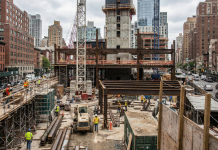In the fields of construction, landscaping, and agriculture, machinery is the key to how well a project goes. Of the machines that are used, the compact track loader (CTL) has become very versatile and integral. As the market for compact equipment is set to grow steadily by 2023, it is valued at over $15 billion and is projected to expand through to 2030. It is important to know what makes these machines stand out so much for business owners and contractors.
Compact track loaders are different from heavy-duty loaders; they are, in fact, specially designed to work in spaces that larger equipment can’t. In terms of design and versatility, compact track loaders prove to be a very important purchase for any industry.
1. Superior Traction and Stability
Compact track loaders’ primary feature is their rubber track system. Also, unlike wheeled skid steers, they better distribute the machine’s weight across the ground. That in turn produces a lower ground pressure, which typically is between 4 and 6 psi, and as a result, they do very well in soft, muddy, or sandy terrains, which would cause traditional wheeled loaders to get stuck or to spin out.
A study from the Association of Equipment Manufacturers reports that contractors prefer CTLs for grading and digging, which they attribute to the machines’ better stability. Also in the report it is brought out that landscape professionals greatly count on this feature, which is also true when they are working on fine lawns, as the reduced ground pressure that the CTLs have causes minimal damage to the turf.
2. Versatility with Attachments
Compact track loaders present very diverse functionality, which is what makes them special. They are able to attach over 70 different tools to the machine, which includes augers, trenchers, mulchers, brush cutters, snow blowers, and pallet forks.
For example: For instance:
- A construction firm may use the same CTL for debris transport, utility in digging, and backfill.
- In agriculture farmers use equipment for handling hay bales, clearing brush, or putting out feed.
This is the benefit of adaptability, which in turn saves businesses the purchase of many machines. In 2022 a report by Equipment World found out that almost 65% of small- to medium-sized contractors put forward that attachment flexibility was the primary reason for their investment in a CTL.
3. Compact Size, Big Power
Compact track loaders present a small size but in the same breath have great power, which is in the range of 65 to 100 HP. They are to do heavy-duty work as well as break up concrete but also have the feature of fitting in tight spaces.
Urban development projects that have space constraints tend to use CTLs for material movement and site grading, which in turn avoids the issues larger loaders present. In a talk with Construction Dive, it was noted that compact track loaders allow contractors to put big power in small areas, which in turn saves time and reduces labor costs.
4. Operator Comfort and Advanced Technology
Modern compact track loaders are very small machines that the manufacturers have designed for the operator’s comfort and productivity. What is found are features like air-conditioned cabs, ergonomic joysticks, and full 360-degree visibility, which also play to better safety and reduced operator fatigue.
Also, it is seen that large producers are putting into their CTLs smart technology like
- Telematics solutions, which include machine use tracking, fuel consumption, and maintenance.
- Automatic bucket adjustment systems for precise grade control.
- Hydraulic quick connect fittings for rapid attachment changeout, which take minutes and do not require the operator to leave the cab.
Technology not only improves efficiency but also extends the life of the machine with preventive maintenance alerts.
5. Cost Efficiency and Long-Term Value
Although at first the price of compact track loaders may be greater than skid steers’, they in the end prove to have greater value. CTLs have better undercarriage wear resistance and also do a better job in poor conditions, which in turn reduces downtime.
A report from Equipment Watch shows that which is true for compact track loaders: that they retain on average 62% of their original value after 5 years, which is better than what is seen for many other types of compact equipment. This high resale value in turn makes them a great choice for contractors looking to get the most out of their investment.
Also, it has been noted that many companies that are in search of compact track loaders for sale report seeing that new models come with financing options, warranties, and service packages, which in turn add great value.
6. Environmental and Safety Benefits
Compact track loaders also have the unique feature of low environmental impact. They are able to work on very delicate terrain, which in turn reduces soil erosion and damage to the landscape.
Safety is a key issue. In terms of visibility, which is improved, rollover protection systems (ROPS), which are present, and low vibration levels, CTLs have great accident prevention features. OSHA is still to stress the point that which equipment is put into use must protect not only the operator but also the ground crew and that compact track loaders do in fact meet the marks.
7. Growing Popularity Across Industries
The past decade has seen an increase in the use of CTLs. Based on research by Off-Highway Research, in 2017 compact track loaders outsold skid steers in North America. That is attributed to the fact that they perform better in a variety of jobs.
Industries that see great benefit from compact track loaders (CTLs) are construction, agriculture, landscaping, and snow removal. In construction CTLs are very much used for grading, hauling, backfilling, and material handling. In agriculture they support land development, feed management, and crop care. Also in the field of landscaping, these machines are used for sod installation, thatch removal, and overall lawn maintenance. Also in the winter months, CTLs play a key role in snow removal, which they do very efficiently when fitted with snow blade attachments.
Conclusion
What sets the compact track loader apart is the mix of power and flexibility, as well as the performance it brings to many applications. In terms of performance, they feature excellent traction, a wide array of attachments, a compact yet very powerful design, and also very advanced operator technology, which is what has made them a mainstay at modern job sites.
For contractors, landscapers, and farmers looking for durable equipment that provides great value in the long term, the latest in compact track loaders is a step in the direction of better efficiency and performance. As sectors grow to require flexible, durable, and eco-friendly equipment, much will be given to compact track loaders, which will play a very large role in the future of work.











